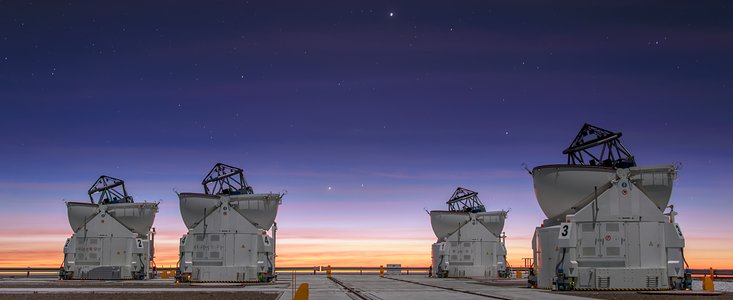Mitteilung
First Light für NAOMI
Neues hochmodernes adaptives Optikmodul für das Interferometer am Very Large Telescope des ESO
7. Dezember 2018
Das New Adaptive Optics Module for Interferometry (NAOMI) wurde erstmals in Betrieb genommen, nachdem es an allen vier 1,8-Meter-Hilfsteleskopen (Auxiliary Telescopes, ATs) des Very Large Telescope Interferometers (VLTI) der ESO am Paranal-Observatorium in Chile installiert wurde. Durch die Einführung modernster adaptiver Optiktechnologie hat NAOMI die Abbildungsfähigkeit des VLTI auf ein noch nie dagewesenes Niveau angehoben und ermöglicht den leistungsstarken wissenschaftlichen Instrumenten des VLTI wie GRAVITY einen klareren Blick auf das Universum als je zuvor.
Das VLTI ist ein Modus des Very Large Telescope (VLT) der ESO, das alle vier ATs oder die 8,2-Meter-Einzelteleskope des VLT zu einem virtuellen Teleskop mit einem Durchmesser von bis zu 130 Metern kombinieren kann. So ermöglicht dieser Modus äußerst hochauflösende Beobachtungen. Mit dem VLTI können Astronomen stellare Oberflächen, aktive galaktische Kerne, junge Sterne und eine Vielzahl anderer faszinierender astronomischer Objekte untersuchen.
Um den Auswirkungen atmosphärischer Turbulenzen auf die Qualität der vom VLTI durchgeführten Beobachtungen zu begegnen, hat die ESO das neue adaptive Optiksystem NAOMI entwickelt. Das System wurde konstruiert, um die Empfindlichkeit und Leistung der ATs des VLT in Zusammenarbeit mit dem Institut de Planétologie et d’Astrophysique de Grenoble (IPAG, Centre National de la Recherche Scientifique/Université Grenoble Alpes) zu verbessern.
Die Entwicklung von NAOMI war eine enorme, technisch anspruchsvolle Aufgabe. „Die neu installierten Module müssen das Licht in nur wenige Mikrometer breite Glasfasern bündeln – kaum ein Zehntel der Breite eines menschlichen Haares!“, erklärte Jean-Philippe Berger von der IPAG. „Wir standen auch vor der großen Herausforderung, die vier adaptiven optischen Systeme so schnell wie möglich zu installieren, um die VLTI-Beobachtungen nicht zu stören.“
Zuvor waren die ATs mit dem weniger ausgeklügelten STRAP-System (System for Tip/tilt Removal with Avalanche Photodiodes) ausgestattet, das die Auswirkungen von atmosphärischen Turbulenzen beobachtete und die Neigung der empfangenen Wellenfronten durch schnelles Einstellen eines Lenkspiegels korrigierte. Trotz der wertvollen Korrekturen, die es unter guten atmosphärischen Bedingungen lieferte, nahm die Bildqualität bei schlechten Bedingungen deutlich ab.
„Die Beobachtung mit dem VLTI an den ATs war früher stark von den Witterungsbedingungen abhängig und nach jedem Sonnenuntergang haben wir gespannt darauf gewartet, ob es eine gute Nacht wird“, erklärte Julien Woillez, VLTI-Projektwissenschaftler. „NAOMI ändert das alles – wir können jetzt auch bei weniger guten Bedingungen effizient beobachten.“
Durch den Einsatz eines fortschrittlichen adaptiven Optiksystems [1] wird NAOMI die Präzision der mit dem VLTI durchgeführten Messungen verbessern und eine bessere und stabilere Bildqualität erreichen. Die rasiermesserscharfe neue adaptive Optik des VLTI ermöglicht effiziente, lange Integrationen auch bei schlechter Sicht – und holt das Beste aus den VLTI-Instrumenten unter allen atmosphärischen Bedingungen heraus.
„An manchen Abenden sieht es so aus, als wäre die Atmosphäre fast verschwunden! Wir können jetzt viel lichtschwächere Objekte beobachten“, schloss Woillez. „Mit NAOMI können wir jetzt modernste Instrumente der zweiten Generation wie PIONIER, GRAVITY und MATISSE optimal nutzen.“
Fußnoten
[1] Eine Schlüsselkomponente von NAOMI ist ein deformierbarer Spiegel der Firma ALPAO – in einer optischen Besonderheit wird die Form dieses Spiegels 500 mal pro Sekunde aktualisiert, so dass die Sicht des VLTI nahezu frei von atmosphärischen Turbulenzen ist.
Links
- Weitere Informationen über NAOMI
- Technische Publikation über NAOMI
- Technische Publikation über den deformierbaren Spiegel von NAOMI
Kontaktinformationen
Calum Turner
ESO Public Information Officer
Garching bei München
Tel: +49 89 3200 6670
Email: pio@eso.org
Über die Mitteilung
| ID: | ann18089 |
Our use of Cookies
We use cookies that are essential for accessing our websites and using our services. We also use cookies to analyse, measure and improve our websites’ performance, to enable content sharing via social media and to display media content hosted on third-party platforms.
ESO Cookies Policy
The European Organisation for Astronomical Research in the Southern Hemisphere (ESO) is the pre-eminent intergovernmental science and technology organisation in astronomy. It carries out an ambitious programme focused on the design, construction and operation of powerful ground-based observing facilities for astronomy.
This Cookies Policy is intended to provide clarity by outlining the cookies used on the ESO public websites, their functions, the options you have for controlling them, and the ways you can contact us for additional details.
What are cookies?
Cookies are small pieces of data stored on your device by websites you visit. They serve various purposes, such as remembering login credentials and preferences and enhance your browsing experience.
Categories of cookies we use
Essential cookies (always active): These cookies are strictly necessary for the proper functioning of our website. Without these cookies, the website cannot operate correctly, and certain services, such as logging in or accessing secure areas, may not be available; because they are essential for the website’s operation, they cannot be disabled.
Functional Cookies: These cookies enhance your browsing experience by enabling additional features and personalization, such as remembering your preferences and settings. While not strictly necessary for the website to function, they improve usability and convenience; these cookies are only placed if you provide your consent.
Analytics cookies: These cookies collect information about how visitors interact with our website, such as which pages are visited most often and how users navigate the site. This data helps us improve website performance, optimize content, and enhance the user experience; these cookies are only placed if you provide your consent. We use the following analytics cookies.
Matomo Cookies:
This website uses Matomo (formerly Piwik), an open source software which enables the statistical analysis of website visits. Matomo uses cookies (text files) which are saved on your computer and which allow us to analyze how you use our website. The website user information generated by the cookies will only be saved on the servers of our IT Department. We use this information to analyze www.eso.org visits and to prepare reports on website activities. These data will not be disclosed to third parties.
On behalf of ESO, Matomo will use this information for the purpose of evaluating your use of the website, compiling reports on website activity and providing other services relating to website activity and internet usage.
Matomo cookies settings:
Additional Third-party cookies on ESO websites: some of our pages display content from external providers, e.g. YouTube.
Such third-party services are outside of ESO control and may, at any time, change their terms of service, use of cookies, etc.
YouTube: Some videos on the ESO website are embedded from ESO’s official YouTube channel. We have enabled YouTube’s privacy-enhanced mode, meaning that no cookies are set unless the user actively clicks on the video to play it. Additionally, in this mode, YouTube does not store any personally identifiable cookie data for embedded video playbacks. For more details, please refer to YouTube’s embedding videos information page.
Cookies can also be classified based on the following elements.
Regarding the domain, there are:
- First-party cookies, set by the website you are currently visiting. They are stored by the same domain that you are browsing and are used to enhance your experience on that site;
- Third-party cookies, set by a domain other than the one you are currently visiting.
As for their duration, cookies can be:
- Browser-session cookies, which are deleted when the user closes the browser;
- Stored cookies, which stay on the user's device for a predetermined period of time.
How to manage cookies
Cookie settings: You can modify your cookie choices for the ESO webpages at any time by clicking on the link Cookie settings at the bottom of any page.
In your browser: If you wish to delete cookies or instruct your browser to delete or block cookies by default, please visit the help pages of your browser:
Please be aware that if you delete or decline cookies, certain functionalities of our website may be not be available and your browsing experience may be affected.
You can set most browsers to prevent any cookies being placed on your device, but you may then have to manually adjust some preferences every time you visit a site/page. And some services and functionalities may not work properly at all (e.g. profile logging-in, shop check out).
Updates to the ESO Cookies Policy
The ESO Cookies Policy may be subject to future updates, which will be made available on this page.
Additional information
For any queries related to cookies, please contact: pdprATesoDOTorg.
As ESO public webpages are managed by our Department of Communication, your questions will be dealt with the support of the said Department.


